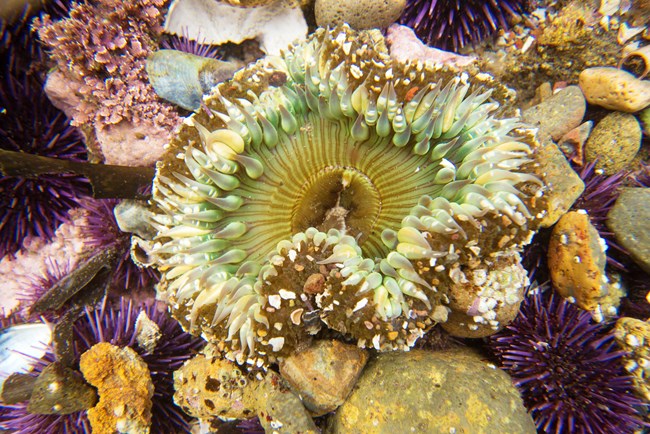
NPS / Jessica Weinberg McClosky
Why We Care
Some of the best examples of rocky intertidal habitat in southern California occur at parks in the Mediterranean Coast Network. The rocky intertidal zone is an area between marine and terrestrial habitats where organisms living within this zone are well adapted to alternating exposures to both the air and sea. The "undisturbed tidepools" are unique features specifically mentioned in the enabling legislation establishing Channel Islands National Park.
Despite the intertidal community's resistance to the drying sun and pounding surf, it is vulnerable to impacts caused by humans. The diversity of species offers visitors a chance to experience a relatively pristine intertidal marine community. Cabrillo National Monument in San Diego hosts tens of thousands of visitors to the tidepools each year. However, visitors can cause damage through trampling, rock turning, or removal of organisms. Pollution is also a major threat to intertidal organisms, being particularly vulnerable to major oil spills.
Because the rocky intertidal community is a major significant ecosystem on the islands and is susceptible to human-caused disturbances, Channel Islands National Park began long-term monitoring of the rocky intertidal zone in 1982 and Cabrillo National Monument began monitoring in 1990.
How We Monitor
Park researchers monitor twenty-one sites on five islands twice each year at Channel Islands National Park.
- Fixed photoplots and point-intercept transects are used to monitor the percent cover of core species.
- Circular plots and timed searches are used to collect information on size distribution and relative abundance of owl limpets, black abalone and ochre sea stars.
- Data are submitted to the Multi-Agency Rocky Intertidal Network (MARINe), a regional consortium of government and non-government entities established to standardize the collection of rocky intertidal data throughout the Pacific coast

NPS
Last updated: September 24, 2021
